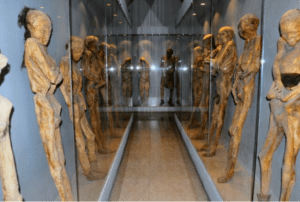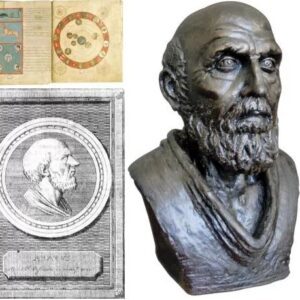
The story of Howard Carter and his team being plagued by deaths after opening King Tut’s tomb is well-known, and some believe that it was not a coincidence. Unfortunately, this is not the only instance of disturbing the dead leading to severe consequences. A recent example is the exhibit of traveling Mexican remains, which could be the latest case of a “mummy’s curse,” as it has been revealed that they carry a fungus that could potentially infect humans.
Mummies of Guanajuato
One example of such cursed remains is the Guanajuato Mummies, which were unearthed in the 1850s and caused terror with their perfectly preserved bodies that appeared to be screaming in fear. These were the bodies of individuals whose families couldn’t pay the required grave tax implemented by the city during a horrific cholera epidemic, and a total of 111 bodies were exhumed from the Guanajuato cemetery as a result.

Human remains, known as the Guanajuato Mummies, lined up against a wall in Mexico, c. 1955
Due to the graves they were buried in and the hot climate, the bodies in the Guanajuato cemetery mummified before they could decompose, resulting in their perfect preservation. News of this eerie discovery spread quickly, and people began paying the gravediggers to see them. Eventually, the mummies were moved to a proper museum and placed in glass cases to ensure their continued preservation.
A fungus is found
The popularity of the Guanajuato mummies continued to grow beyond Mexico, as a traveling exhibition was established in the United States in 2009. These mummies have also been moved around within Mexico, including a recent display of six mummies at a fair in Mexico City. However, the National Institute of Anthropology and History has expressed concern over the potential risk of a dangerous fungus carried by the mummies, which could potentially expose the public to harm.

One of the naturally mummified bodies in Guanajuato, Mexico, 1952
Representatives released a statement saying, “From some of the published photos, at least one of the corpses on display, which was inspected by the institute in November 2021, shows signs of a proliferation of possible fungus colonies.” The main concern is that the Institute wasn’t asked to advise on the display, so they aren’t sure whether the mummies were stored in cases that would stop the fungus from reaching visitors. Any gaps in the glass could allow the spores to escape and be inhaled by the public.
Infecting humans?
The Institute has not only raised concerns about the potential risk but also hopes for a comprehensive study to determine if the fungus poses a risk to the cultural legacy and to those who handle or view the mummies. Although it is uncertain whether this particular fungus poses a risk to humans, it would not be the first time that fungus has been associated with a curse on mummies. In fact, fungus may be considered the original mummy’s curse.

Guanajuato Mummies in the Museo de Las Momias, 2008
As for well-documented cases, 10 of the 12 researchers present when King Casimir IV’s tomb was opened in 1970 died, presumably from fungus. Researchers actually took the time to investigate the mummy of Ramses II when it was moved to Paris in 1976, and they were able to find 89 different fungi, including the deadly Aspergillus.
THE END!





